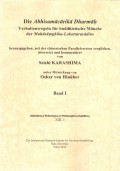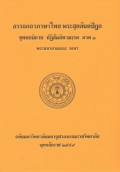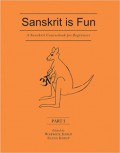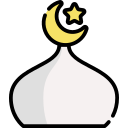“Friendly Advice” and “King Víkrama’s Adventures”
The best-selling Hitopadeśa gives its reader much more than “Friendly Advice.” In one handy collection—closely related to the world-famous Pañcatantra or “Five Discourse on Worldly Wisdom…
- ครั้งที่จัดทำ
- -
- ISBN/ISSN
- 9780814783054
- ลักษณะวัสดุ
- 742 pp.
- ชื่อชุด
- Clay Sanskrit library, 32.
- เลขหมู่
- -
Rama’s Last Act
“Rama’s Last Act” by Bhava·bhuti is counted among the greatest Sanskrit dramas. The work at once dramatizes the “Ramáyana”—it is one of the earliest theatrical adaptations of Valmíki…
- ครั้งที่จัดทำ
- -
- ISBN/ISSN
- 9780814767337
- ลักษณะวัสดุ
- 458 pp.
- ชื่อชุด
- Clay Sanskrit library, 31.
- เลขหมู่
- -
Maha·bhárata IX: Shalya (volume two of two). Cantos 30-65
In one of the most famous passages in the “Maha·bhárata,” Dur·yódhana, the heroic but flawed king of the Káuravas, meets his end when he is dishonorably defeated in battle by his arch enem…
- ครั้งที่จัดทำ
- -
- ISBN/ISSN
- 9780814757376
- ลักษณะวัสดุ
- 470 pp.
- ชื่อชุด
- Clay Sanskrit library, 30.
- เลขหมู่
- -
“The Lady of the Jewel Necklace” and “The Lady Who Shows Her Love”
King Harsha, who reigned over the kingdom of Kanauj from 606 to 647 CE, composed two Sanskrit plays about the mythical figures of King Údayana, his queen, Vásava·datta, and two of his co-wives. …
- ครั้งที่จัดทำ
- -
- ISBN/ISSN
- 9780814719961
- ลักษณะวัสดุ
- 514 pp.
- ชื่อชุด
- Clay Sanskrit library, 27.
- เลขหมู่
- -
Maha·bhárata VIII: Karna (volume one of two). Cantos 1-54
The Maha·bhárata’s ‘Book of Karna’ relates the events of the two dramatic days after the defeat of the great warriors and generals Bhishma and Drona, in which Karna — great hero and the e…
- ครั้งที่จัดทำ
- -
- ISBN/ISSN
- 9780814799819
- ลักษณะวัสดุ
- 604 pp.
- ชื่อชุด
- Clay Sanskrit library, 26.
- เลขหมู่
- -
Maha·bhárata IV: Viráta.
‘Viráta’ is the fourth book of the Maha·bhárata and details the Pándavas’ 13th year in exile, when they live disguised in King Virata’s court. The Pandavas suffer the humiliation of …
- ครั้งที่จัดทำ
- -
- ISBN/ISSN
- 9780814731833
- ลักษณะวัสดุ
- 516 pp.
- ชื่อชุด
- Clay Sanskrit library, 25.
- เลขหมู่
- -
Rama Beyond Price
“Rama Beyond Price,” a dramatised remake of the Ramáyana, is one of the most challenging pieces of Sanskrit poetry to read. Because of its elegant style, learned allusions and often striking i…
- ครั้งที่จัดทำ
- -
- ISBN/ISSN
- 9780814782958
- ลักษณะวัสดุ
- 638 pp.
- ชื่อชุด
- Clay Sanskrit library, 24.
- เลขหมู่
- -
Maha·bhárata VII: Drona (volume one of four). Cantos 1-54
After Bhishma is cut down at the end of the previous book of the Maha·bhárata, the book which bears his name, Duryódhana selects Drona as leader of his forces. Drona accepts the honour with Bhis…
- ครั้งที่จัดทำ
- -
- ISBN/ISSN
- 9780814767238
- ลักษณะวัสดุ
- 473 pp.
- ชื่อชุด
- Clay Sanskrit library, 23.
- เลขหมู่
- -
The Recognition of Shakúntala
The play Shakúntala was one of the first examples of Indian literature to be seen in Europe, first translated into English, and then into German. It attracted considerable attention (from Goethe, …
- ครั้งที่จัดทำ
- -
- ISBN/ISSN
- 9780814788158
- ลักษณะวัสดุ
- 419 pp.
- ชื่อชุด
- Clay Sanskrit library, 22.
- เลขหมู่
- -
Maha·bhárata II: The Great Hall.
The ‘Great Hall’ is Book Two of the Maha·bhárata, one of India’s two national epics. This magnificent book relates some of the most seminal events of the epic, culminating in the famous gam…
- ครั้งที่จัดทำ
- -
- ISBN/ISSN
- 9780814794067
- ลักษณะวัสดุ
- 588 pp.
- ชื่อชุด
- Clay Sanskrit library, 21.
- เลขหมู่
- -
Ramáyana V: Súndara
The fifth and most popular book of the Ramáyana of Valmíki, “Súndara” recounts the adventures of the monkey hero Hánuman in leaping across the ocean to the island citadel of Lanka. Once the…
- ครั้งที่จัดทำ
- -
- ISBN/ISSN
- 0814731783
- ลักษณะวัสดุ
- 538 pp.
- ชื่อชุด
- Clay Sanskrit library, 20.
- เลขหมู่
- -
Five Discourses on Worldly Wisdom
The king despairs of his idle sons, so he hires a learned brahmin who promises to make their lessons in statecraft unmissable. The lessons are disguised as short stories, featuring mainly animal pr…
- ครั้งที่จัดทำ
- -
- ISBN/ISSN
- 9780814762080
- ลักษณะวัสดุ
- 562 pp.
- ชื่อชุด
- Clay Sanskrit library, 19.
- เลขหมู่
- -
Ramáyana III: The Forest
This is the third book of the seven books of India’s most beloved and influential epic tale—the Ramáyana of Valmíki. This third book carries forward the narrative by following the exiled hero…
- ครั้งที่จัดทำ
- -
- ISBN/ISSN
- 9780814767221
- ลักษณะวัสดุ
- 436 pp.
- ชื่อชุด
- Clay Sanskrit library, 17.
- เลขหมู่
- -
Messenger Poems
Kali·dasa’s fifth-century CE “Cloud Messenger” is a beautiful and pure expression of an exiled lover’s love. That first messenger poem is imitated in the twelfth century in the “Wind Mes…
- ครั้งที่จัดทำ
- -
- ISBN/ISSN
- 9780814757147
- ลักษณะวัสดุ
- 293 pp.
- ชื่อชุด
- Clay Sanskrit library, 16.
- เลขหมู่
- -
Rákshasa’s Ring
The final, benedictory stanza of this political drama may refer to Emperor Chandra Gupta II (r. c.376-415 CE). Other than this clue to the date of the author, all we know about him is that he came …
- ครั้งที่จัดทำ
- -
- ISBN/ISSN
- 9780814716618
- ลักษณะวัสดุ
- 385 pp.
- ชื่อชุด
- Clay Sanskrit library, 15.
- เลขหมู่
- -
Maha·bhárata IX: Shalya (volume one of two). Cantos 1-29 Maha·bhárata I…
“The Book of Shalya” is the ninth book of the Maha·bhárata. It portrays, in grand epic style, the last day of the great battle between the Káuravas and the Pándavas, recounting in gory deta…
- ครั้งที่จัดทำ
- -
- ISBN/ISSN
- 9780814757062
- ลักษณะวัสดุ
- 371 pp.
- ชื่อชุด
- Clay Sanskrit library, 14.
- เลขหมู่
- -
Ramáyana IV: Kishkíndha
After losing first his kingship and then his wife, Rama goes to the monkey capital of Kishkíndha to seek help in finding Sita, and meets Hánuman, the greatest of the monkey heroes. The brothers V…
- ครั้งที่จัดทำ
- -
- ISBN/ISSN
- 9780814752074
- ลักษณะวัสดุ
- 415 pp.
- ชื่อชุด
- Clay Sanskrit library, 12.
- เลขหมู่
- -
Three Satires
Written over a period of nearly a thousand years, these works show three very different approaches to satire. Nila·kantha gets straight to the point: swindlers prey on stupidity. When asked …
- ครั้งที่จัดทำ
- -
- ISBN/ISSN
- 9780814788141
- ลักษณะวัสดุ
- 403 pp.
- ชื่อชุด
- Clay Sanskrit library, 11.
- เลขหมู่
- -
Love Lyrics
Ámaru’s sophisticated seventh-century CE “Hundred Poems” are as much about the social aspects of courting, betrayal, feminine indignance and masculine self-pity as about sensuality. Bhartri�…
- ครั้งที่จัดทำ
- -
- ISBN/ISSN
- 9780814799383
- ลักษณะวัสดุ
- 327 pp.
- ชื่อชุด
- Clay Sanskrit library, 9.
- เลขหมู่
- -
Ramáyana II: Ayódhya
In the great city of Ayódhya, the king decides to abdicate in favor of his beloved son Rama; but just as the celebrations reach their climax, a court intrigue involving one of the king’s junior …
- ครั้งที่จัดทำ
- -
- ISBN/ISSN
- 9780814767160
- ลักษณะวัสดุ
- 652 pp.
- ชื่อชุด
- Clay Sanskrit library, 8.
- เลขหมู่
- -




 Computer science, information & general works
Computer science, information & general works
 Philosophy & psychology
Philosophy & psychology
 Religion
Religion
 Social sciences
Social sciences
 Language
Language
 Pure Science
Pure Science
 Applied sciences
Applied sciences
 Arts & recreation
Arts & recreation
 Literature
Literature
 History & geography
History & geography